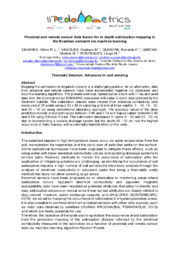Proximal and remote sensor data fusion for in-depth salinization mapping in the Brazilian semiarid via machine learning.
Proximal and remote sensor data fusion for in-depth salinization mapping in the Brazilian semiarid via machine learning.
Autoria: TAVARES, S. R. de L.; VASQUES, G. de M.; OLIVEIRA, R. P. de; DANTAS, M. M.; RODRIGUES, H. M.
Resumo: Mapping the salinization in irrigated cropland is a challenging practice. As an alternative, data from proximal and remote sensors have been implemented together via datafusion and machine learning algorithms. The present work was carried out on a farm with 11 ha and used data from the proximal sensor EM38-MK2 associated with radar C-band data obtained by the Sentinel1 satellite. The salinization classes were created from electrical conductivity data measured at 35 points using a 50 x 50 m sampling grid and at three depths: 0 ? 10, 10 ? 30, and 30 ? 50 cm using conventional laboratory approach. The accuracy values of the class prediction models presented values between 0.66 and 0.74 and Kappa values between 0.43 and 0.59 using Random Forest. The salinization decreased in layers 0 - 10 and 10 - 30 cm due to implementing a surface drainage system but the depth 30 - 50 cm had the highest occurrence of Salic classes, with a potentially harmful effect on the roots.
Ano de publicação: 2022
Tipo de publicação: Artigo em anais e proceedings
Unidade: Embrapa Solos
Palavras-chave: Remote sensing, Sensoriamento Remoto
Observações
1 - Por padrão são exibidas publicações dos últimos 20 anos. Para encontrar publicações mais antigas, configure o filtro ano de publicação, colocando o ano a partir do qual você deseja encontrar publicações. O filtro está na coluna da esquerda na busca acima.
2 - Para ler algumas publicações da Embrapa (apenas as que estão em formato ePub), é necessário ter, no celular ou computador, um desses softwares gratuitos. Sistemas Android: Google Play Livros; IOS: iBooks; Windows e Linux: software Calibre.
Acesse outras publicações
Acesse a Base de Dados da Pesquisa Agropecuária (BDPA) para consultar o acervo completo das bibliotecas da Embrapa.

